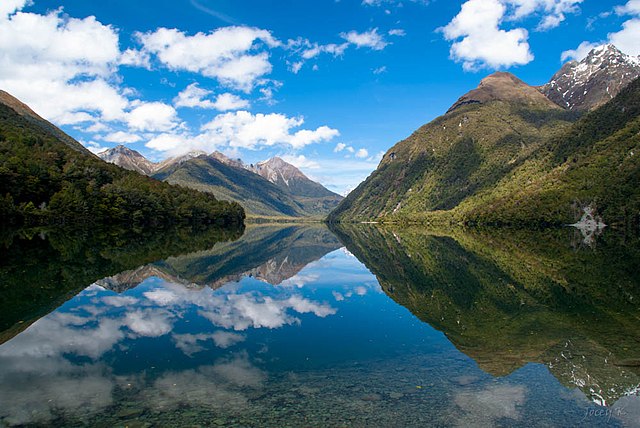 |
| Lake Gunn, New Zealand. [A] |
Aotearoa New Zealand, much like Australia, is a rich country. Much more than Australia, NZ is world-famous for its astounding natural beauty and its blessed climate. Even if readers never visited it, film franchises like The Lord of the Rings have showcased its magnificent natural scenery.
That beauty, peacefulness (somewhat tainted now by the recent and regrettable Christchurch events), and geographical isolation have made of NZ attractive to many. Just a couple of years ago, even Silicon Valley billionaires -- most notably Peter Thiel -- “discovered” NZ as a kind of “apocalypse insurance” or, as I prefer to call it, up-market Doomsday prepping destination.
It is, therefore, with alarm that I read the official triennial report Environment Aotearoa 2019 -- jointly by the NZ Ministry for the Environment and Stats NZ -- made public yesterday. Highlights from it:
- 75 animal and plant species extinct after human settlement;
- 90% seabirds and 80% shorebirds threatened or at risk of extinction;
- heightened extinction risk for 86 species during the last 15 years;
- risk of collapse for 2/3 of NZ ecosystems.
I want to share with readers something in particular from that report. The infographic below, I think, is very educative about the challenges humanity faces.
 |
| (right-click to open a larger image in a separate tab) |
It, I think, is best read from top to bottom, starting by point 5 (“Our climate change”), sub-points 9 and 8. Note what the infographic says immediately after that: “Climate change intensifies the effects of all other issues”.
Contrary to widespread perception -- sadly fostered by well-meaning commentators, activists, the media, and even by some climate change scientists -- climate change isn’t the only cause of ecosystem collapse: it intensifies other causes. Those other causes, however, often remain unmentioned: out of sight, out of mind.
The truth is humanity won’t be automatically off the hook by solving the already daunting problem of climate change. Those other causes (namely, the destructive way how we use “our freshwater and marine resources” and “our lands”, the “pollution from our activities”) will still need to be addressed.
The views that report reflects seem coincident with those expressed in the recently published article “Worldwide decline of the entomofauna: A review of its drivers”, by Francisco Sánchez-Bayo.
----------
Speaking of extinctions:
 |
| (source) |
If the population of the Yarra pygmy perch (Nannoperca obscura) went extinct in the wild, it wasn’t because of lack of trying. Attempts to “restock” the river were made after the population crashed precipitously during the millennium drought: industrial quantities of inbred fish, produced in nurseries, were released in the wild. The problem is that -- apparently to the surprise of the plan’s promoters -- the reintroduced fish didn’t survive in the wild. You see right there why the policy of David Littleproud reeks of cretinism: a wild population is not a farm population, Einstein.
----------
If you -- like me -- thought Autumn could bring a pause in the avalanche of terrible Summer news, think again. It turns out that now there are reports of unusual crocodile and shark deaths in the Northern Territory:
 |
| (source) |
So far I could find only one media report, mentioning only a small number of dead animals. Which is good. Hopefully, there’s nothing to see here. The bad news is that the number of sightings of living crocodiles in reproductive age may be falling:
“Back in the day we used to have 16-foot crocs that would come up to the back of the boat every night, the clients used to love it and you got to see nature,” he [Anthony Bergamo, a recreational fishing business owner] said.
“We saw one crocodile yesterday which was about 2 feet long, you know, and that is just regular now that there are no crocs here.”
Image Credits:
[A] Lake Gunn, New Zealand. Author: Jocey K. Source: WikiMedia. File licensed under the Creative Commons Attribution-Share Alike 2.0 Generic license. My use of this file in no way implies the licensor endorses me or said use.
No comments:
Post a Comment